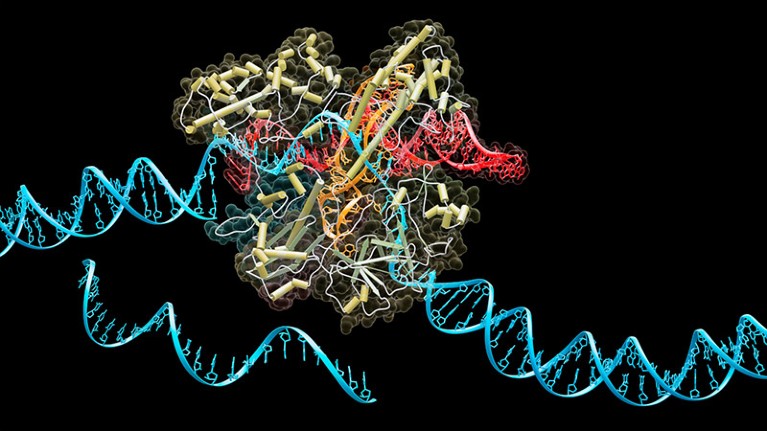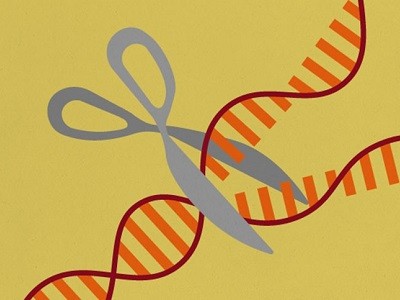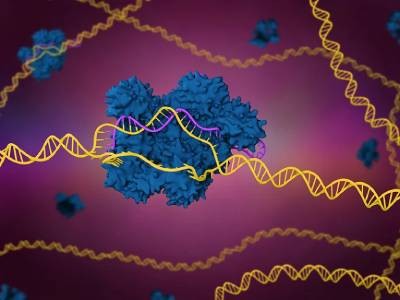
The CRISPR–Cas9 system (pictured) is used to find and cut specific DNA sequences.Credit: Carlos Clarivan/Science Photo Library
CRISPR–Cas9 is best known as a laboratory tool for editing DNA, but its natural function is as part of the immune system that helps certain microorganisms to fight off viruses. Now, researchers have used an algorithm to sort through millions of genomes to find new, rare types of CRISPR system that could eventually be adapted into genome-editing tools.
“We are just amazed at the diversity of CRISPR systems,” says Feng Zhang, a biochemist at the Massachusetts Institute of Technology in Cambridge and co-author of a 23 November paper in Science that describes the systems1. “Doing this analysis kind of allows us to kill two birds with one stone: both study biology and also potentially find useful things.”
Trove of CRISPR-like gene-cutting enzymes found in microbes
Single-celled bacteria and archaea use CRISPR systems to defend themselves against viruses known as bacteriophages. The systems generally have two parts: ‘guide RNA’ molecules that recognize and bind to phage DNA or RNA, and enzymes that cut or otherwise interfere with the genetic material at the site indicated by the guide RNA.
Until now, researchers had identified six types of CRISPR system, designated I–VI. These have different properties, including the type of enzyme they use and how they recognize, bind to and cut RNA or DNA. The CRISPR–Cas9 system commonly used for genetic engineering is classed as type II, but the characteristics of other CRISPR types could make them useful for other applications.
Similar sequences
To find diverse CRISPR systems in nature, Zhang, MIT bioengineer Han Altae-Tran and their colleagues developed an algorithm called FLSHclust, which analyses genetic sequences in public databases. These databases contain hundreds of thousands of genomes from bacteria and archaea, hundreds of millions of sequences that haven’t been linked to a particular species and billions of genes that encode proteins. FLSHclust found CRISPR-associated genes by looking for similarities between genetic sequences and grouping them into about 500 million clusters.
By looking at the predicted function of the clusters, the researchers found around 130,000 genes associated in some way with CRISPR, 188 of which had never been seen before, and tested several in the lab to find out what they do. Their experiments reveal various strategies that CRISPR systems use to attack bacteriophages, including unwinding the DNA double helix, and cutting DNA in ways that allow genes to be inserted or deleted. They also identified ‘anti-CRISPR’ fragments of DNA that might help a phage to escape bacterial defences.
Is CRISPR safe? Genome editing gets its first FDA scrutiny
Among the new genes was the code for an entirely unknown CRISPR system that targets RNA, which the team dubbed type VII. Co-author Eugene Koonin, a biologist at the National Center for Biotechnology Information in Bethesda, Maryland, says that it’s increasingly hard to find new CRISPR systems. Type VII — and any other types that haven’t yet been identified — must be extremely rare in nature, he adds. “It will probably take monumental efforts to find the next type.”
It’s hard to know whether certain types of CRISPR system are rare because they are not generally useful to microorganisms or whether they are specifically adapted to an organism that lives in a particular environment, says Christine Pourcel, a microbiologist at Paris-Saclay University. She adds that because the genetic databases used in the study include fragments of genomes that aren’t linked to specific organisms, it will be difficult to study the roles of some of the new systems.
Impressive haul
The algorithm itself is a major advance, in that it will allow researchers to look for other types of protein across species, says Chris Brown, a biochemist at the University of Otago in Dunedin, New Zealand. “I’m impressed with what they could do,” he says.
“It’s a treasure trove for biochemists,” agrees Lennart Randau, a microbiologist at the University of Marburg in Germany. The next step, he says, will be to work out the mechanisms through which the enzymes and systems work, and how they could be adapted for biological engineering. Brown says that some CRISPR proteins chop up DNA at random and are useless for engineering. But they are so precise at detecting DNA or RNA sequences that they might make good diagnostic or research tools.
It’s too soon to say whether type VII CRISPR systems or any of the other genes identified by FLSHclust will be helpful for genetic engineering, says Altae-Tran, but they have some properties that could be useful. Type VII, for instance, involves only a very few genes that could easily fit in a viral vector and be delivered into cells. By contrast, some of the other systems the team found contain very long guide RNAs, potentially allowing them to target particular genetic sequences with unprecedented accuracy.



